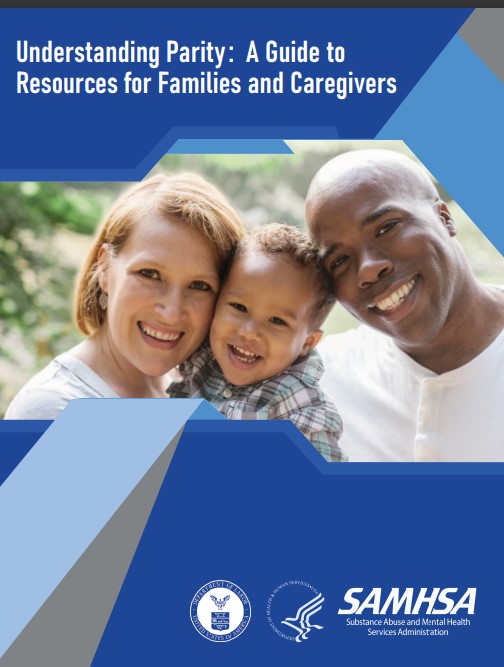Understanding Parity

Understanding Parity
A GUIDE TO RESOURCES FOR FAMILIES
AND CAREGIVERS
Understanding Parity – If you care for someone with a mental illness or substance use disorder, this guide can be a helpful resource. There are protections in federal law, collectively known as “parity,” which are designed to ensure that certain types of health plans cover mental health and substance use disorders no less generously than the way they cover other health issues. Health plans are often referred to as “health insurance.”
Caring for a child (or parent, patient or client or family member) takes a lot of dedication of time, resources, and emotions. Struggling to find access to behavioral health services can be frustrating. The full implementation of parity laws not only can provide broader access to services for immediate behavioral health needs, but these laws are also important to ensuring a healthy future for people we care about.
Early identification and treatment of behavioral health conditions, especially for children and adolescents, facilitated by parity compliance, can prevent behavioral conditions from getting worse and ultimately causing more serious problems later in life.
Federal parity protections are therefore truly an investment in the future health of our children and families, and indeed all individuals living with behavioral health conditions. This document aims to provide you as a parent, family member or caregiver with some helpful information and tools necessary to obtain the behavioral health services for the child or family member in your care.
The U.S. Department of Health and Human Services (HHS) has jurisdiction over public-sector group health plans, while the Department of Labor (DOL) and the U.S. Department of the Treasury (Treasury) have jurisdiction over private group health plans.
The laws can be complicated, but this resource is intended to guide you to materials and places that can help. It includes an annotated list of materials, websites, and organizations that provide more information about the following:
1. Parity Applies to How You Access Care and What You Pay
2. Most, But Not All, Health Plans Are Covered by Parity Laws
3. Health Plans Must Provide Information About the Mental Health and Substance Use Disorder Benefits They Offer
4. You Have a Right to Appeal a Claim That Is Denied
5. Additional Help Is Available
PARITY APPLIES TO HOW YOU ACCESS CARE
AND WHAT YOU PAY
Parity applies to rules related to how mental health and substance use disorder treatment is accessed and under what conditions treatment is covered, whether permission is needed from your health plan. Benefit limitations that are not numeric are called non-quantitative treatment limitations, or NQTLs. There are special parity rules that apply to NQTLs.
Parity also means that financial requirements, such as copayments or deductibles, and numeric treatment limits such as how many visits your coverage will pay for, must be at least as generous for mental health and substance use disorder services as for physical health services. Benefits SECTION 3 limitations that are numeric are called quantitative treatment limitations, or QTLs.
Here are some examples of how parity protections are
beneficial:
• There can be no limit on the number of visits for in network outpatient mental health and substance use disorder care, if there is no limit on the number of visits for in-network outpatient physical health care.
• The standard and basis for prior authorization requirements for mental health and substance use disorder services must be comparable to, or less restrictive than, those for physical health services. Prior authorization (sometimes called preauthorization, prior approval, or precertification) means that a health care provider from your plan must confirm that a service is needed before it begins.
• Plans must apply comparable or lower copays for out-of network inpatient mental health and substance use disorder care than for out-of-network inpatient physical health care.
• A health plan must use a similar or less restrictive process to create and apply medical necessity standards for mental health and substance use services, compared to the process used for physical health services. If your plan denies payment for these services, your plan must give you a written explanation of the reason for the denial and must provide more information upon request.
2. MOST, BUT NOT ALL, HEALTH PLANS ARE
COVERED BY PARITY LAWS
Parity only applies to health plans that provide mental health and substance use disorder benefits. In general parity applies to:
• Private-sector employment-sponsored group health plans with 51 or more workers.
• Private plans of smaller employers that started offering health insurance benefits or made major changes to their health insurance plans after March 23, 2010.
• Plans sponsored by non-federal governmental employers with 51 or more workers (although self-insured non-Federal governmental plans can opt out if they follow certain procedures).
• Most health insurance coverage sold to individuals, including coverage sold through the Health Insurance Marketplace.
• Most, but not all, Medicaid managed care programs and all Children’s Health Insurance Program (CHIP) programs.
ADDITIONAL RESOURCES
HealthCare.gov
This HHS website will help to understand and use the
individual insurance market. It includes information about how to enroll in or change your health plan, the essential health benefits that Marketplace and other plans are required to cover (including mental health and substance use disorder services), and how to use your health insurance coverage.
Link: https://www.healthcare.gov/
Application of MHPAEA to Medicaid and CHIP – PowerPoint Presentation
This presentation from CMS explains how MHPAEA applies to those who receive coverage under Medicaid and CHIP.
Medicaid and Parity Website
This Website explains parity requirements for Medicaid plans.
Link: https://www.medicaid.gov/medicaid/benefits/behavioral-health-services/parity/index.html
3. HEALTH PLANS MUST PROVIDE INFORMATION ABOUT THE MENTAL HEALTH AND SUBSTANCE USE DISORDERS BENEFITS THEY OFFER
Health plans subject to MHPAEA and certain other laws must provide information about the mental health and substance use disorder benefits they offer, and you have the right to request this information. Call your health plan administrator or human resources representative for the “summary plan description” and the summary of benefits and coverage” or your insurer for your health insurance policy or certificate.
You can usually find your health plan’s telephone number online or on the back of your health coverage I.D. card. You may also be able to check your health plan benefits online to see what mental health and substance use disorder services are covered and to see what mental health and substance use disorder services are covered and to see if they are comparable to physical health benefits.
READ MUCH MORE INSIDE…
“UNDERSTANDING PARITY” $9

Click on the Blue Button Below for Instant Access!
Our 100% Money Back Guarantee:

If for any reason you decided within 30 days that “UNDERSTANDING PARITY” isn’t for you, simply notify us by email and we’ll gladly refund your money – no questions asked. That’s our Ironclad Guarantee!
The risk is entirely ours! You absolutely have nothing to lose!
Your name and email will Never be shared, sold, or given to anyone.
We keep our subscriber’s privacy sacred. We do not sell or rent your personal information to other parties. What’s more you can always unsubscribe at any time!
Warmest Regards, Coyalita
Behavioral Health Rehabilitative Specialist & Addiction Counselor
Copyright © 2021-2024 Thresholdlivecoyalita.com All Rights Reserved Privacy Policy – Earnings Disclaimer – Terms of Use – Contact Us




